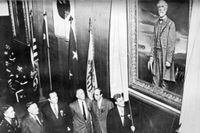In a move that has reignited the country’s ongoing debate about how best to remember the Civil War and its legacy, the Pentagon has restored a 20-foot portrait of Confederate General Robert E. Lee to the library at the United States Military Academy at West Point. The painting, which notably features a slave guiding Lee’s horse in the background, had hung in the library for seven decades before its removal in 2022. Its return on August 29, 2025, marks a significant reversal of recent efforts to strip Confederate symbols and names from military institutions—a campaign that gained momentum in the wake of nationwide protests following the 2020 killing of George Floyd.
According to Latin Times, the painting’s removal three years ago was part of a broader, congressionally mandated push to address the presence of Confederate tributes in American military life. The 2020 law that initiated the change required the Pentagon to excise Confederate names, statues, and memorials from bases and academies, seeking to align these institutions more closely with what lawmakers described as “the best of our national ideals.” West Point’s then-superintendent, Lt. Gen. Steven W. Gilland, pledged that the process would be carried out “with dignity and respect,” emphasizing that the goal was not to erase history but to ensure the academy reflected contemporary American values.
The commission behind these changes, known as the Naming Commission, was created by Congress in 2020 after lawmakers from both parties called for a reckoning with the military’s commemoration of figures who fought for the Confederacy. The law establishing the commission passed over a veto from President Donald Trump, underscoring the contentious nature of the debate. The commission’s final report was clear: “The facts of the past remain, and the commissioners are confident the history of the Civil War will continue to be taught at all service academies with all the quality and complex detail our national past deserves. Rather, they make these recommendations to affirm West Point’s long tradition of educating future generations of America’s military leaders to represent the best of our national ideals.”
As Military.com reports, the portrait of Lee in Confederate uniform was singled out for removal, while portraits of Lee in his U.S. Army uniform—along with references to his time as West Point superintendent—were allowed to remain. The commission argued that honoring Lee’s Confederate legacy was particularly problematic, given his decision to reject a command in the U.S. Army at the start of the Civil War and instead fight for the Confederacy. “The consequences of his decisions were wide-ranging and destructive. Lee’s armies were responsible for the deaths of more United States soldiers than practically any other enemy in our nation’s history,” the commission wrote.
Lee’s deep ties to West Point only complicated the issue. He graduated second in his class in 1829 and later returned to serve as superintendent from 1852 to 1855, years before he became the Confederacy’s most famous general. The portrait in question, first installed in 1952 during the height of the so-called Lost Cause movement, depicts Lee in his Confederate uniform—a visual that, for many, symbolizes the attempt to recast the Confederacy’s cause as noble and unconnected to slavery. The presence of a slave in the background of the painting has been cited by critics as a stark reminder of the realities the Confederacy fought to uphold.
The Trump administration has made no secret of its desire to reverse the commission’s work. Both President Trump and Defense Secretary Pete Hegseth have been outspoken in their support for restoring Confederate names and monuments that were removed from military sites over the past five years. Hegseth recently called for the return of a Confederate memorial to Arlington National Cemetery, which had been removed at Congress’s recommendation. In a statement defending the portrait’s return, Army communications director Rebecca Hodson said, “At West Point, the United States Military Academy is prepared to restore historical names, artifacts, and assets to their original form and place. Under this administration, we honor our history and learn from it—we don’t erase it.”
Earlier this summer, the administration found a workaround to the 2020 law by rebranding some bases that had previously been renamed. The new namesakes share the same surnames as Confederate generals, a move that officials say technically complies with the letter of the law while symbolically restoring Confederate-linked names. This legal maneuver has frustrated lawmakers on both sides of the aisle, prompting a new amendment in this year’s defense policy bill to close the loophole and force stricter adherence to the original intent of the law.
The restoration of the Lee portrait is not an isolated event. The administration has also called for a review of Smithsonian Institution exhibitions, aiming to replace what it describes as “divisive or ideologically driven language” with “unifying, historically accurate and constructive descriptions” within 120 days. President Trump has accused the Smithsonian of promoting “race-centered ideology,” declaring in a social media post that the institution is “OUT OF CONTROL.” Smithsonian secretary Lonnie G. Bunch III was summoned to the White House for discussions on the matter, as the administration presses for a shift in how national museums present American history.
These moves have drawn criticism from historians, military veterans, and civil rights advocates, who see them as part of a broader attempt to sanitize or revise the nation’s past. Andrew J. Bacevich, a retired colonel and West Point graduate, described the continued honoring of Lee at the academy as “something of an obscenity,” according to The New York Times. Many argue that restoring Confederate symbols undermines efforts to reckon honestly with the United States’ history of slavery and racial injustice.
Supporters of the administration’s approach, however, counter that history should not be erased or rewritten to fit contemporary sensibilities. They argue that restoring artifacts like the Lee portrait is about respecting the complexity of the past and ensuring that future generations can learn from it—warts and all. As Hegseth put it in a recent social media post, the restoration is simply “respecting history that was being erased by ‘woke lemmings.’”
The debate over Confederate symbols at West Point and other military institutions is far from settled. For now, the 20-foot portrait of Robert E. Lee once again hangs in the West Point library, a potent symbol of the country’s ongoing struggle to define how it remembers—and learns from—its own history.

